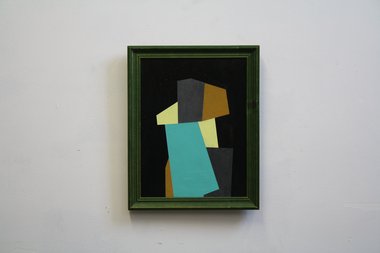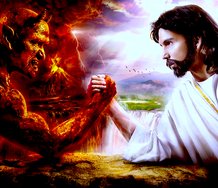Roger Boyce – 21 November, 2014
With this exhibition's untitled work de Lautour welds Suprematism, Synthetic Cubism (with Early and Late Modernism) to an irreverent color schema (lemon yellows, charcoal, turquoise, et al) issuing fully-formed from mid twentieth century consumer goods and design. Consumer design in the 1950s and 60s (from lounge furnishings to two-tone runabouts) was borrowed, often willy-nilly, from the Bauhaus. But designers of the time typically infused Bauhaus rectitude with enough irreverent, designerly, nervous energy to effectively mimic the energy-signature of consumer-targeted Levittown house fraus, wired up on Dexedrine diet-pills and Hammond-organ-combo jazz. I would imagine, given de Lautour's biological vintage, he would have come of age surrounded with this particular panoply of consumer-design - all the more dazzling against the otherwise beige tussock vistas of Canterbury.
Suprematism and Synthetic Cubism - the art historical edifices against which this particular de Lautour insouciantly slouches - is underwritten by aspirational metaphysics. Suprematism and Synthetic Cubism’s origin myths, as much about what isn’t as what is there - the sub-genre’s internally, delimiting shouldn’t(s) seeking to trump any and all historically dictating should(s).
As if compounding a palliative for at least one of Plato’s ‘plaints - “Thus (through perspective) every sort of confusion is revealed within us…” - Suprematists renounced orthographic perspective in favor of a volumetrically and compositionally reductive auto-da-fé.
Malevich’s trademark squares are, for the purposes of this metaphorically dubious paragraph, perpendicular views of volumetrically flattened boxes. Dogmatically 2D phylacteries, fashioned to encapsulate and ritualistically fix to art’s body a previously heterogeneous holy ghost of painting.
Malevich and mates, in so doing, hoped to (through a sort of Neo-Platonic transfiguration) deliver painting from its longstanding, and hobbling, contractual bondage to institutional patrons - to liberate painting from its pictorialist, bondservant, status. To free painting from its servile serial utility, as litigant for a historically perpetual lineage of ideologically contracting masters.
Digressing briefly here: It wasn’t long after Supermatists codified their dogma that the Soviet insisted Malevich and his mates construct cheerfully propagandistic cubist peasants from their patented set of anhedonic, obdurately-non-objective, blocks.
Tony de Lautour has a history with history. Previously, and prominently, with the pictorial history of demotic, often monstrous, visual culture - tattoo-flash, toilet-stall graffiti, lowbrow cartoons, op-shop paintings - the sorts of adolescently transgressive emblems and symbols one finds carved onto schoolroom desktops and biro-scrawled into the margins of grammar-school copybooks. Salvaged and culturally redeemed images, derived from variously dubious, pedigreed, precincts of visual culture - scrounged from the curbside free-box of picture making.
De Lautour has, in the past, more often than not, strategically aligned his practice with the cumulative side of an aggregative/reductive divide. A partisan divide running like a tectonic fissure, down the center of strategic visual culture. Given de Lautour is a connoisseur, a collector of sorts - his habitually demonstrated tendency is to amass discriminative visual collections. Derived visual aggregates, divorced from clinging notions of authorship, or fealty to any binding form, genre, or style - dependent wholly on de Lautour’s willful discrimination, taste and sensibility.
Conversely, the modus operandi of proto-modernists - such as The Supermatists, and modernists they presupposed - is earnest, protean, origination and authorship - an arguably sui generis undertaking. So how (or why) is it that de Lautour seeks to add the countervailing (uber-earnest, utopian) raft of Supermatist and Synthetic Cubist tenets to his growing pile of arbitrary-in-their-abundance possibilitiy?
In slovenly effort to answer that question I’ll here lapse into generalities: When one relocates/repositions a trope (visual or otherwise), or willfully alters its formal structure and/or its contextual relationships - as is de Lautour’s long-established method - one sets about constructing a visual realm of syntactic (or perhaps, more accurately, ‘global’) ambiguity. Globally ambiguous artifacts, unlike their locally ambiguous cousins, defy resolution. Leaving viewers to rely absolutely on their own constellations of probability. Works such as de Lautour’s are not so much dictatorial as suggestive. Not as much vehicles for apprehendable meaning as allusive vessels formidably ballasted by surplus, and ambiguously associative, possibility.
With this exhibition’s untitled work de Lautour welds Supermatism, Synthetic Cubism (with Early and Late Modernism) to an irreverent color schema (lemon yellows, charcoal, turquoise, et al) issuing fully-formed from mid twentieth century consumer goods and design. Consumer design in the 1950s and 60s (from lounge furnishings to two-tone runabouts) was borrowed, often willy-nilly, from the Bauhaus. But designers of the time typically infused Bauhaus rectitude with enough irreverent, designerly, nervous energy to effectively mimic the energy-signature of consumer-targeted Levittown house fraus, wired up on Dexedrine diet-pills and Hammond-organ-combo jazz. I would imagine, given de Lautour’s biological vintage, he would have come of age surrounded with this particular panoply of consumer-design - all the more dazzling against the otherwise beige tussock vistas of Canterbury.
Here de Lautour’s shifting pile of Supermatist blocks arrange themselves - within an avocado-green found frame - obliquely suggesting the compositional conventions of head-and-shoulder portraiture - a blatantly heretical thing to do with Supermatism’s ‘altar piece’ blocks. The painting, although religiously flat, entertains subtle, material traces of previous compositional (nudging late-modernist, formal painterliness?) try-outs beneath the enamel-like black of the painting’s ground.
Quadrilateral turquoise, yellow, charcoal, and ochre shapes, conjure jazzy 50s/60s surface-pattern-design such as restaurant counter-tops and loud salesmen’s ties. Material paint failure (surface cracking and seemingly inadvertent paint-passage translucencies) summons, as if by happenstance, the shopworn material fallibility of Slavic Ikon paintings - the fiercely formal native body of work that got the Russian Supermatist’s thinking about flat and formal, in the first place.
De Lautour here indentures, and in doing so demotes, his art-historically ‘sacred’ sources, in the same fearless manner he previously liberated, and apotheosized, low-status images. In de Lautour’s perverse egalitarianism lies the invigorating rub his pictures provide.
Catalogue essay by Roger Boyce

 Advertising in this column
Advertising in this column Two Rooms presents a program of residencies and projects
Two Rooms presents a program of residencies and projects
This Discussion has 0 comments.
Comment
Participate
Register to Participate.
Sign in
Sign in to an existing account.